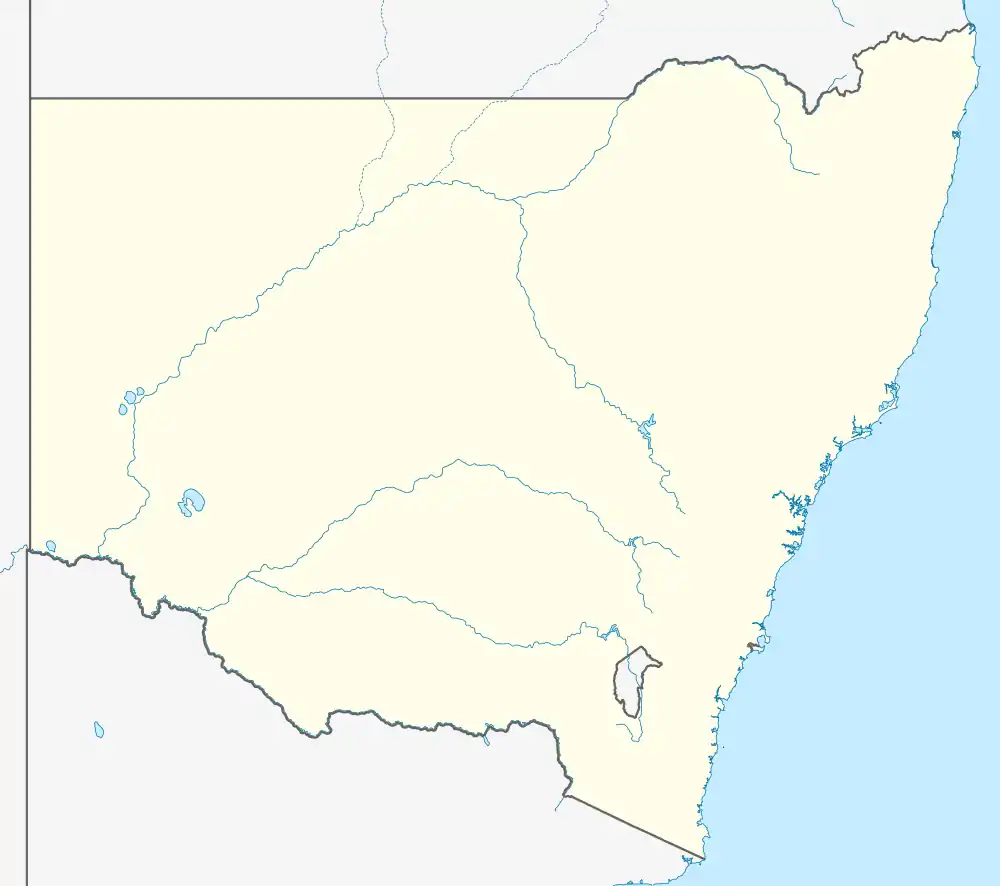Tuena
Tuena is a town in the Southern Tablelands of New South Wales, Australia, in Upper Lachlan Shire. It is located on Tuena Creek, tributary of the Abercrombie River, 269 km (167 mi) west of the state capital, Sydney.[2] At the 2016 census, Tuena and the surrounding area had a population of 59.[1]
| Tuena New South Wales | |||||||||||||||
|---|---|---|---|---|---|---|---|---|---|---|---|---|---|---|---|
 Goldfields Inn | |||||||||||||||
 Tuena | |||||||||||||||
| Coordinates | 34°02′S 149°20′E | ||||||||||||||
| Population | 59 (2016 census)[1] | ||||||||||||||
| Postcode(s) | 2583 | ||||||||||||||
| Location | |||||||||||||||
| LGA(s) | Upper Lachlan Shire | ||||||||||||||
| Region | Southern Tablelands | ||||||||||||||
| County | Georgiana | ||||||||||||||
| Parish | Yarraman | ||||||||||||||
| State electorate(s) | Goulburn | ||||||||||||||
| Federal Division(s) | Hume | ||||||||||||||
| |||||||||||||||
Only nine months after the first payable discovery of gold in Australia at Ophir (start of the Australian gold rushes), gold was found at Tuena.
History
The site was first explored by Dr. Charles Throsby in 1819, with the first landholder, Samuel Blackman, arriving in 1836. In May 1859, Tuena was formally declared a town.[3]
Gold was discovered at Tuena in November 1851, although gold had been discovered on the Abercrombie River (the Tarshish Diggings), 10 km north some months earlier.[4] The following extract from a contemporary newspaper announces the discovery at Tuena.
Bathurst Free Press and Mining Journal (Newspaper), 15 November 1851: —
- On the latter part of last week, news arrived on the river, and was quickly circulated through the surrounding country that very, rich diggings had been discovered on Tuena Creek, at one of Mr. Smith's sheep stations, known by the name of the Sapling Hut. He proceeded to the place and found a body of men very busily engaged digging up the bed of one of his sheep-yards and procuring gold in abundance.[5]
Rapid growth due to the gold rush saw construction of many buildings, a post office and police station in 1852, three pubs including the Goldfields Inn (1866), Parson's store, a courthouse (1860s) and a school (1860). The current school dates only to 1889.
The town also boasts three churches - St. Mark's Anglican (1886), thought to be the oldest timber 'miner's church' still standing, the stone St. Margaret's Presbyterian (1890), and St. Mary's Catholic Church in 1896 (built of bricks from the old Cordillera mine).
The heavily forested and mountainous countryside, nearby Abercrombie Caves, and presence of the goldfields made Tuena an attraction for bushrangers including Ben Hall, Gardiner, John Vane, Johnny Gilbert, John O'Meally, Cummins, and Lowry.
References
- Australian Bureau of Statistics (27 June 2017). "Tuena (State Suburb)". 2016 Census QuickStats. Retrieved 7 July 2017.

- "Tuena". Website. Argyle County. 18 March 2009. Retrieved 27 October 2012.
- "Tuena: Historic Gold Mining Village". Tourism Pamphlet. 2000.
- "The Tarshish diggings - Abercrombie River". Newspaper. Bathurst Free Press and Mining Journal. 10 September 1851. p. 2. Retrieved 29 October 2012.
- "Important Intelligence From The Tarshish Diggings". Bathurst Free Press and Mining Journal. 15 November 1851. p. 4. Retrieved 28 October 2012.
External links
| Wikimedia Commons has media related to Tuena. |
- Argyle County - Southern Tableland tourism site